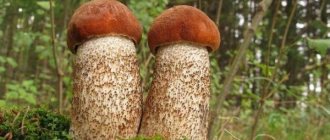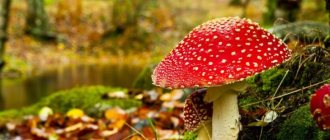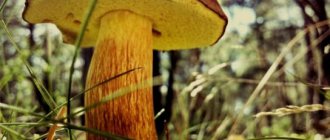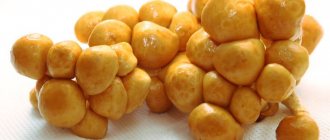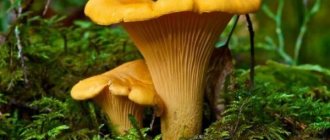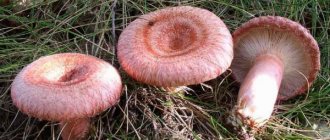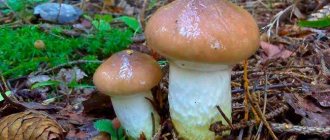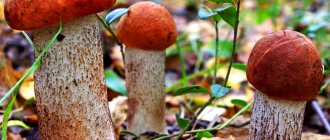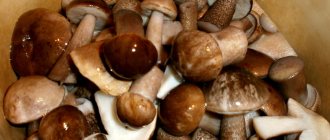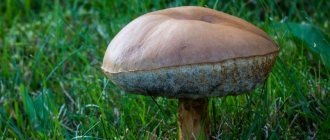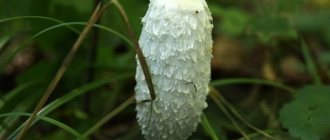Red boletus is an edible mushroom, widely distributed throughout the CIS. Belongs to the genus Leccinum, family Boletaceae, tubular group.
The red boletus is an elegant inhabitant of the forest, with an appearance very characteristic of mushrooms: a red-brown cushion-shaped cap and a light leg. However, the properties of red boletus are not limited to this.
The mushroom belongs to the second category of nutritional value and is distinguished by high nutritional, culinary and taste qualities.
Red boletus (red cap) is one of the best edible mushrooms. In terms of nutritional value and taste, it is in no way inferior to the common boletus and is in second place after the porcini mushroom.
The pulp is thick, dense, fleshy. A pleasant rich taste will complement any dish. The use of red boletus is also possible as the basis of a culinary masterpiece. Does not require lengthy preliminary preparation. Based on this, red boletus is used in cooking as widely as porcini mushroom. Suitable for all types of workpieces.
Another benefit of the red boletus is that it is extremely rarely affected by worms and is unusually prolific.
Red boletus. Latin name : Leccinum aurantiacum (Boletus aurantiacus Bull).
Red boletus. Other names : common boletus, red mushroom, red mushroom, aspen mushroom, red mushroom, red mushroom.
Related species
Boletus is a group of species of mushrooms of the genus Leccinum (boletus). In addition to boletuses, this genus includes a group of boletuses. Representatives of both groups are edible mushrooms.
The main distinguishing features of boletuses are:
- the flesh turns blue when cut;
- the leg is thicker, stockier;
- the flesh of the cap is denser.
In addition to the red boletus species, more than a dozen species are classified as aspen boletuses. The most common:
- red-brown boletus (yellow-brown) – Leccinum versipelle;
- white boletus – Leccinum percandidum;
- black-scaled boletus – Leccinum atrostipiatum;
- oak redhead – Leccinum quercinum;
- redhead pine – Leccinum vulpinum;
- red spruce grass – Leccinum piceinum;
- colored-legged boletus – Tylopilus chromapes (Leccinum chromapes).
Other black mushrooms
Truffle black
It grows in the southeastern part of France, Spain and Italy. It grows underground, at a depth of 5–30 cm. It mainly prefers to live on poor calcareous soils in the vicinity of oak and hazel trees. It has no stem or cap, is a black tuber, like a potato, from 3 to 9 cm in diameter. Edible.
Mainly used for making sauces and desserts. In small quantities it can be used raw as a savory and aromatic seasoning. Previously, it was assumed that this was not a mushroom at all, but a growth on the roots of trees.
It is collected with the help of trained pigs, who find it by smell. It is called the “diamond on the table” for its high cost and the “capricious prince” because it previously appeared only among the aristocracy.
Muer black
It grows in subtropical and temperate continental zones on all continents. Since the fungus is a saprophyte, its main habitat is weakened or dead trunks of deciduous trees. Sometimes it settles on tree stumps. The body is a gelatinous formation, shaped like an auricle or sometimes a flat semicircle.
Young mushrooms are translucent; as they age, they turn black. Edible. Used mainly in oriental cuisine.
It is prepared in various ways, by boiling or frying, added to salads and soups, and marinated with hot spices. This mushroom tolerates drying well. It is rarely used as a main dish due to its neutral taste. Dried mushrooms are soaked in water for 3–4 hours, after which they increase in volume by 6–8 times.
It is also called the “Ear of Judas” for its striking similarity to the human ear. In Chinese medicine, a large number of medicines based on muer have been created. It is believed that it helps cope with cancer and strengthen the immune system.
Chaga
Grows in birch forests (Russian, Eastern European, North American, Korean, Chinese, Japanese). The body of the mushroom is a black growth on a birch trunk with a diameter of 5 to 40 cm, a thickness of 10–15 cm. Second name: “Birch mushroom.” Inedible. Used in medicine and cosmetology. Known for its high content of biologically active substances.
Mushrooms are collected from living trees, most often in late autumn or early spring, when chaga is most noticeable on the trunk. The pulp is cut into small pieces and dried at a temperature not exceeding 60 degrees Celsius. After drying, you can grind it. Used in the form of tinctures of water or alcohol.
Distinctive feature: the mushroom lives for about 20 years. Fungal spores, entering a wound on a tree trunk, infect it. Over time, the infected tree dies. The mushroom is rich in micro- and macroelements. The infusion is believed to help fight cancer.
Important! Some mushrooms contain the alkaloid psilocybin. When consuming psilocybin mushrooms, you can experience hallucinations, depression of consciousness, euphoria, delirium, and paranoia. Their collection, procurement and cultivation are prohibited by the legislation of the Russian Federation.
Shiitake
It grows in subtropical zones on all continents. Its main habitat is weakened or dead trunks of deciduous trees. Sometimes it settles on tree stumps. The mushroom cap is from 4 to 20 cm in diameter, brown-brown in color. The leg is 1.5 cm in diameter.
The pulp is dense and light. Edible. Often used in oriental cuisine. It is prepared in various ways. Compatible with buckwheat and rice cereals, goes well with all types of meat and fish.
Often used in dairy-based sauces. Due to the large number of useful substances in the composition, it is popular in Eastern medicine. It is also used in cosmetology.
Black mushrooms are much less common than light ones. This rarity scares off many experienced mushroom pickers who are afraid of the black color. These mushrooms are shrouded in an aura of mystery. It’s not for nothing that even in the game “Diablo” there is a level where you need to find a black mushroom. However, black mushrooms are not only suitable for consumption. Many of them are very tasty, some are very valuable, and some have health benefits.
False doubles
The red boletus does not have false doubles that would be poisonous and could be harmful to health. It has the greatest external resemblance to oak boletus and other boletuses. But these are all edible mushrooms. And if, when collected, fellow boletus boletus similar to it end up in the basket, then nothing terrible will happen.
It is much more important not to confuse red boletus with poisonous mushrooms, which pose a threat not only to human health, but sometimes to human life.
False boletus
The only unpleasant counterpart of red boletus is the gall fungus (false boletus, bitterling) - Tylopilus felleus. It is not poisonous, but it is also not suitable for food, since the taste of its pulp is very unpleasant, bitter, acrid, and does not disappear when cooked, but only intensifies. Even a small piece of false boletus can ruin the entire mushroom dish or preparation.
Advice from experienced mushroom pickers
You may be interested in: How do edible talkers differ from false mushrooms? How many days after rain do mushrooms grow? Bitter mushroom: photo and detailed description
To avoid mistakes when picking mushrooms in the forest, you should not neglect the experience of experienced mushroom pickers. First of all, this concerns the question of how to distinguish edible fruits from poisonous ones.
- When picking mushrooms, you need to pay attention to their cap. In edible species it has a spongy structure. Of the poisonous specimens, only the satanic mushroom has a similar feature.
- Under no circumstances should you pick unfamiliar mushrooms, much less taste them!
- Before going into the forest, you should study in detail the types of edible fruits. You can make a reminder that will be convenient to carry with you.
- During “silent hunting”, leaves should be lifted with a stick, not with your hands. Even if the mushroom is poisonous, in this case its poison or spores will not be able to get on the skin.
All these rules must be strictly followed. They are relevant when collecting any types of mushrooms, no matter what color of cap and stem they have.
How to distinguish red boletus from false one?
The main distinguishing features are:
- Unlike red boletus, which grows at the roots of exclusively deciduous trees, mainly aspen, false boletus can also be found on coniferous trees, as well as near rotten stumps, on rotten wood.
- The hymenophore (lower part of the cap) of the gall fungus is pinkish, in old specimens it is dirty pink.
- The leg of the red boletus is covered with numerous white scales, and in the adult mushroom there are dark scales, and in the false boletus it is covered with a reticulate pattern, reminiscent of a porcini mushroom, only dark in color.
- There are no insects on the surface of the gall mushroom, as they are not attracted to its bitter taste.
LiveInternetLiveInternet
Poisonous mushrooms - False mushroom
Danger. grows on the ground, yellow or reddish cap, without scales, black, green or brown plates, no film or ring on the stem, earthy smell.
A characteristic feature of chanterelles is their pleasant fruity aroma. False relatives of the chanterelle are brighter in appearance, yellow-orange in color, with a hollow and thin leg. The edges of her hat are smooth, unlike a real chanterelle.
Description. The boletus is distinguished by a dense, brown-red cap, the flesh turns blue at the break. This is how you can distinguish the edible boletus mushroom from other mushrooms.
Description. Milk mushroom is a lamellar mushroom, white, with fluffy edges, white and acrid milky juice, grows in flocks next to birch trees. This way you can distinguish milk mushrooms from poisonous and inedible mushrooms.
Description. Russulas are lamellar mushrooms, they break easily, the caps are of different colors - pink, brownish, greenish, the skin is easily removed from them. This way you can distinguish edible russula mushrooms from inedible ones.
Poisonous mushrooms contain deadly toxins and that is why eating them is strictly prohibited! Even after long and thorough processing (drying, soaking, salting, etc.), poisonous mushrooms may not lose their harmful substances. Before you go into the forest to pick mushrooms, you need to know, at least in theory, what some types of poisonous mushrooms look like. which can be found in our forests. Every person who likes to go mushroom picking should clearly remember that it is not worth putting unknown mushrooms in the basket.
And most importantly: the pulp of the false chanterelle has a very unpleasant odor.
mushrooms that cause poisoning leading to death.
Danger. white, bitter, acrid milky juice.
Danger. lack of velvety, reddish color of the spongy layer, bitter taste.
Description. The butterdish (butterfly) has a yellow stem and the same cap with white marks on the edges and a sticky skin on top, as if greased with oil, which is easily removed with a knife. Learn to identify poisonous mushrooms.
But if the cap is curved like a dome, it means that the mushroom has already released spores and a poison similar to that of a corpse is formed in it. It is dangerous and is the main cause of poisoning.
It begins to bear fruit at the end of summer to the end of September. Toadstool (pictures) is highly toxic.
The flesh of the mushroom is light yellow, has a bitter taste and an unpleasant odor. The false honey fungus lives from June to October. Most often it can be found in fairly large groups on rotting wood. The mushroom is poisonous and causes digestive upset. After 1-6 hours, signs of poisoning immediately appear: vomiting, loss of consciousness, nausea, excessive sweating.
If you are worried whether a poisonous mushroom has gotten into your basket, know: there are two ways to remove the poison:
There are no reliable methods for distinguishing edible and poisonous mushrooms by eye. Therefore, the only way is to know each of the mushrooms. If the species identity of mushrooms is in doubt, you should under no circumstances eat them. Fortunately, among the hundreds of species found in nature, many have such clearly defined characteristics that it is difficult to confuse them with others.
How to identify poisonous mushrooms
The stalk is approximately 10 cm long and 10 mm wide, often narrowed towards the base. False chanterelles mainly grow in the warm season from July to October, near real chanterelles. Also, this type of mushroom often grows in families, in rare cases alone. The false chanterelle can be easily distinguished from the edible chanterelle: The real chanterelle has a bright yellow color, a concave cap, smooth on top and wavy at the edges. The leg is dense and elastic, slightly darker than the cap.
Mushrooms are not recommended for children, the elderly, or those who suffer from diseases of the gastrointestinal tract. In addition, even healthy people should not consume mushrooms with alcohol or starchy foods, in particular potatoes.
Dry the mushrooms. By the way, this should be done in a warm but well-ventilated room, strung on a thread and hung, and not placed on a radiator or stove. In the first case, the toxin turns into a decoction, in the second it evaporates.
The mushroom has a convex cap up to 5 cm in diameter. The color of the cap is predominantly yellowish with a red or orange tint and a darker color in the center. The mushroom has a thin, smooth, hollow, fibrous stem.
1 milk mushroom; 2 camelina; 3 cone mushroom; 4 greenish russula; 5 edible russula; 6 fox.
However, it is better to always have a mushroom identification tool on hand to distinguish a poisonous mushroom from an edible mushroom.
It is no secret that many poisonous mushrooms are disguised as edible ones. So, let's figure out how to distinguish edible mushrooms from inedible ones. It is worth remembering that even an edible mushroom can cause poisoning. IMPORTANT TO KNOW: Overripe mushrooms with an open cap like an umbrella have no nutritional value. It is better to hang such a mushroom on a branch - let the spores spread throughout the area.
If you eat mushrooms and feel unwell, consult a doctor immediately. While the ambulance is driving, drink 4-5 glasses of boiled water at room temperature (a weak solution of potassium permanganate or soda solution) in small sips. This is done to induce vomiting and flush out your stomach. The mortality rate from mushroom poisoning is very high - from 50 to 90% in the regions of Russia. There are tragic cases where entire families died. IMPORTANT TO KNOW: In general, mushrooms are a very difficult product to digest.
Pale toadstool is perhaps the most poisonous mushroom! It is better to avoid poisoning with toadstool! The appearance of this mushroom is practically not much different from other mushrooms growing in forests, so it can easily be confused with an edible mushroom. The color of the cap of this toadstool is yellowish-brown, pale greenish or greenish-olive.
Danger. discoloration at the break, reddish spongy layer, bitter taste.
Danger. rare plates, sharp blueness and stone hardness at the fracture, absence of birch trees nearby.
How to identify edible mushrooms
Poisonous mushrooms - Pale toadstool
Danger: the wrong hat is not pink, unfurled, without hairiness.
We wish you a pleasant quiet hunt. And remember that mushrooms brought home must be processed on the same day. The exception is lamellar mushrooms - they can be soaked overnight.
mushrooms with local irritant effects (food intoxication);
Description. The boletus is distinguished by a white leg with bright scales, the cap is brownish on top, the cap is white below, and the flesh at the break is white. These are the main differences between an edible mushroom and how edible boletus mushrooms are distinguished from inedible mushrooms.
This may be the end of the matter, but sometimes, after the first symptoms, severe damage to the liver, pancreas, and kidneys develops. Death may occur. This is why you should never self-medicate!
Description. Honey mushrooms are pecked by families on stumps, roots, and trunks of dead trees. The cap of the honey fungus is ocher-colored, covered with small black scales directed from the middle, underneath there are whitish plates, and on the stem there is a white ring or film.
Description. The porcini mushroom is distinguished by a thick and dense stem, a brown cap, white flesh, and a pleasant taste and smell. Porcini mushrooms are quite easy to distinguish from poisonous ones.
Danger. the mushroom does not grow under its own tree.
Danger. red or brown-black cap, pink leg, reddened or darkened soft film on the leg, coarse and hard pulp, unpleasant and bitter taste.
7 - red fly agaric; 8 - variegated champignon; 9 - Russula emetic; 10 — value; 11 - entoloma.
Usually the center of the cap is darker in color than its edges. The structure of this type of mushroom is quite fleshy, with cylindrical stripes of pale green color. On top of the leg there is a ring of striped pale or white color. Pale grebe (photo) forms mycorrhiza on deciduous trees, growing in mixed and deciduous forests.
mushrooms that cause disturbances in the central nervous system;
Let's figure out what differences between poisonous and edible mushrooms novice mushroom pickers need to know. What you should pay attention to when picking mushrooms, what mushroom lovers should be wary of, and how to avoid becoming a victim of poisonous mushrooms.
Poisonous mushrooms in Russian forests
ORDER ON THE OFFICIAL WEBSITE
Differences between poisonous and edible mushrooms
The first signs of mushroom poisoning are similar to many other pathologies:
Therefore, when going on a mushroom hunt, it is important to become thoroughly familiar with the representatives of poisonous mushrooms.
The first signs of mushroom poisoning - what to do in case of mushroom poisoning
The mortality rate from poisoning with poisonous mushrooms reaches 90% in some cases! Poisonous mushrooms are especially dangerous for children. The main distinguishing feature of poisonous mushrooms is the presence of deadly substances in them, and not external similarity or the absence of any normal mushroom characteristic.
Poisonous mushrooms - False chanterelle (orange talker)
After all, even the smallest mushroom is poisonous. processed together with other mushrooms can lead to serious consequences.
Poisonous mushrooms of Russia: How to identify a poisonous mushroom, how to distinguish an edible mushroom
What to do to avoid mushroom poisoning
Poisonous mushrooms are mushrooms that, when consumed in normal doses, cause severe poisoning. Based on the nature of the action of toxins, poisonous mushrooms are divided into three groups:
Description. Moss mushrooms have a dark green or reddish velvety cap, a yellow stem and a spongy layer. These are the main signs by which you can distinguish the edible flywheel mushroom from inedible mushrooms.
7 oilers; 8 morel; 9 porcini mushroom; 10 large umbrella; 11 row; 12 field champignon.
Danger. discoloration at the break, bitter taste. Do not confuse the white mushroom with the poisonous yellow one; when cut, its flesh turns pink.
Description. Camelina is a lamellar mushroom of the corresponding color, secreting a milky orange juice and not bitter in taste. This is how to distinguish the edible saffron mushroom from its look-alike mushrooms.
Danger. red-orange color, empty stem.
Description. Volnushka is a lamellar mushroom with a shaggy pink cap, curved at the edges, white and acrid milky juice. These are the distinctive features of the wave.
Description. Chanterelle is dense, apricot or light orange in color, the plates from under the cap smoothly turn into a dense and durable stem. A way to distinguish the edible chanterelle mushroom from inedible mushrooms.
How to distinguish a poisonous mushroom - How to distinguish edible mushrooms
This poisonous mushroom has a brightly colored cap from orange-red to copper-red. The shape of the false chanterelle's cap resembles a funnel with a smooth edge. The plates of the mushroom are bright red, sinuous.
1 - paneolus; 2 — gray float; 3 — glowing talker; 4 - common veselka; 5 - pale grebe; 6 - white fly agaric (spring).
The false honey fungus is similar in appearance to the autumn, winter, summer and gray-plate honey fungus.
Danger. the mushroom does not grow under its own tree.
Both of these methods do not work on only one mushroom - toadstool.
vomiting, diarrhea, weakness, high fever.
Botanical description
What does red boletus look like? The cap is thick and easily separated from the stem. In young mushrooms, it is hemispherical, the edges are tightly pressed to the stem; as the mushroom grows, it becomes convex-prostrate, then cushion-shaped. The edge of the cap of the red boletus is thin, bent, with the skin hanging down along the edge, later pubescent.
The skin is initially velvety-fibrous, matte and dry, then becomes bare. Occasionally slightly damp. It is removed with great difficulty, and pieces of pulp come off. The skin color of the red boletus varies from light to red-orange, dark red, brick-red, fading with age. Diameter: 4-20, up to 30 cm.
The lower part of the cap (hymenophore) of the reddish boletus has notched or free tubes. The color of the tubular layer of red boletus in young mushrooms is whitish, with age it changes to light gray with an olive tint to dirty gray and brown in old and wormy specimens.. Length of the tubes: 7-30 mm. Thickness: 1-3 cm.
The pores are small and round. Color: initially white, creamy, then olive, brownish-gray. Darkens when touched. Spores are smooth, fusiform. Color: yellowish-brown. Size: 13-17 x 4-5 microns. Color of red boletus spore powder: brown, olive-brown, after drying tobacco-brown.
The leg of the red boletus is central, solid, cylindrical, often thickened towards the base. Colour: greyish white. Covered with white longitudinal fibrous scales, which as the mushroom matures become rusty-brown or chestnut-brown. Height: 5-18 to 20 cm, diameter: 1.5-5 cm.
The flesh of the red boletus is thick and fleshy. In young specimens it is dense, hard, in older specimens it is soft and loose.. Color: gray, white. When cut, it changes first to gray-violet, bluish, later to brownish-red, and finally to gray-black. Taste: pleasant, mushroom. There is no pronounced aroma.
Conditionally edible varieties
Conditionally edible are those varieties that can be used for food only after pre-treatment. They are boiled, soaked, doused with boiling water (blanched) or dried. After completing one of these procedures, you can begin preparing the main mushroom dish. Among the owners of red caps, the following semi-edible species are distinguished:
- The red milk mushroom is characterized by a reddish-brown color of the cap, the diameter of which reaches 20 cm. Most often, the surface of the mushroom is light brown, but milk mushrooms are also found with a rich orange and red color. The fruit pulp is quite brittle, white or with a reddish tint. The cut area smells like boiled crabs or fish.
- The yellow-red row is characterized by a matte fleshy cap of yellow-orange or yellow-red color. The diameter of the cap can reach 15 cm. There are small burgundy scales on the surface. The pulp is yellow in color, has a fresh taste and sour aroma.
- Brick-red honey fungus is considered a false honey fungus and belongs to the conditionally edible representatives of the mushroom world. The diameter of the fleshy cap varies between 4-12 cm, and its color is red-brown, brick-red or brown-yellow. The pulp is white with a yellow tint and has a bitter taste. The leg grows up to 10 cm and has a fairly dense consistency. You can meet honey fungus in summer and autumn on dead wood and stumps of deciduous trees.
Habitat
Red boletus is widespread throughout the forest zone of Eurasia. It can be found even in the north, in the tundra, among dwarf birches. In the CIS countries this is the European part, North-West Russia, the Caucasus, the Urals, Western Siberia, and the Far East. They prefer rocky soil, rich in leaf humus, and moderately moist soil.
Where does red boletus grow? Unlike some of its closest relatives, the mushroom does not have strictly one partner tree with which it enters into symbiosis. It forms mycorrhiza (symbiosis with the roots of the plant) with many deciduous trees: poplar, less often willow, as well as oak, beech, hornbeam, birch. But it gives preference to aspen - it is especially abundant above its roots. Does not grow near coniferous trees.
Where to collect red boletus? The fungus prefers young trees. First of all, these are pure aspen forests or single aspen trees. It can also be found in mixed or deciduous woodlands, in clearings, forest edges, and along forest roads.
It grows singly or in families, often quite large.
Names of edible mushrooms with red caps
Mushrooms with red caps can be found in almost any forest. And they look very beautiful and unusual. Some species with red caps can be used in cooking without fear.
Redhead
Red boletus, or redhead, is an edible mushroom from the group of laticifers, which got its name due to its ability to form mycorrhiza with aspen. Also, the color of its cap is similar to the shade of aspen leaves.
Young fruits have a spherical cap, which is located on a massive, thick stalk. When the fruit ripens, the cap opens and its edges diverge. In mature mushrooms it is round and red or brick-colored.
The size of the leg is 5 cm in diameter. At first it is gray, then brownish. Below you can usually notice a pronounced thickening.
On a note! Although redcap is most often found in aspen areas, it also bears fruit near other deciduous trees. In most cases they appear near young trees. And some representatives of this group are found even in the tundra.
Marsh Russula
Swamp russula is also called floater. She is not afraid of any weather conditions - neither rain nor drought.
This species lives in Eurasia and North America. Fruits from the second half of July to the end of September. Grows in swamps and other areas with damp, wet soil.
The mushroom has a bright red color, for which it received its second name - float. Like, you can see it from afar, like a float on the water. The center of the fruit's cap is especially distinct and bright. Pinkish inclusions appear along the edges.
The stem of the mushroom is round and has a cavity inside. Its height is 4-10 cm, and its diameter is approximately 2 cm. It is smooth and dry to the touch, white in color. The pulp is elastic, hard, dense. It has no distinct odor, but has a bitter taste. It is usually used in food after marinating or salting.
Chemical composition
Nutritional value depends on the chemical composition of red boletus. The plant contains mono- and disaccharides, amino acids, including essential, unsaturated fatty acids, etc. Vitamins A, E, C, B1, B2, PP are also present.
Macro- and microelements in the composition of red boletus make up about 1.5% and are represented by the following: potassium (404 mg), phosphorus (90 mg), magnesium (16 mg), sodium (6 mg), calcium (3 mg), iron ( 0.3 mg), potassium, etc.
Important! The information presented in the material is for informational purposes only. Before use, be sure to consult a specialist.
Application
Representatives of this mushroom family are used not only for preparing all kinds of culinary dishes. They are widely used in cosmetology and folk medicine.
It is believed that mokrukha has a beneficial effect on all organs of our body. The presence of antibacterial substances in this mushroom determines the effectiveness of its use as a therapeutic and prophylactic agent. Modern medicine confirms that mokrukha is effective in the treatment of viral diseases. In many countries, this mushroom is used to treat migraines, nervous system disorders, headaches and insomnia. It is assumed that such a product has a positive effect on the general condition of the body, helps strengthen the immune system and is effective in the fight against chronic fatigue.
Cosmetics that contain the spruce fly fungus (preparing such potions at home is not difficult) make the skin more elastic and silky. Lotions, infusions and decoctions relieve redness and inflammation. Along the way, they have a beneficial effect on skin color - it becomes smooth and matte. Creams with mokrukha are recommended for owners of oily skin prone to enlarged pores.
Decoctions and special masks made from mokrukha help strengthen and grow hair. After using such products, the hair becomes silky and shiny. Since ancient times, this mushroom has been used in folk medicine to eliminate dandruff and split ends.
Calories and nutritional value
The red boletus plant is a healthy and nutritious product. Contains a rich set of vitamins, macro- and microelements. So in its fresh form, the mushroom is not inferior to cereals in terms of the amount of B vitamins, and vitamin PP - to liver and yeast.
The beneficial properties of red boletus include the fact that it is a rich source of high-quality vegetable protein that can replace protein of animal origin. Thus, broth prepared from this type of boletus is not inferior in nutritional value to beef broth. Based on this, the mushroom can take its rightful place in the diet of vegetarians.
With all its advantages, the calorie content of red boletus is low (per 100 grams of product), so it can be included in your diet without fear of gaining extra pounds.
| Name | Quantity, gr. | |
| fresh | dried | |
| Calories, kcal | 22 | 239-315 |
| Squirrels | 3,3 | 35,4 |
| Fats | 0,5 | 5,4 |
| Carbohydrates | 1,2 | 12,9 |
| Water | 88,1 | |
| Cellulose | 6 | |
Notable Features
It doesn’t matter where you come across the mokrukha mushroom (you can see photos of representatives of the kingdom of wildlife in the article) - an experienced mushroom picker will never confuse it with anything. However, these mushrooms still differ from each other. They may have different shapes and different colors, and may or may not have a specific smell. It is also worth noting that, depending on the species, the taste qualities of this type of mushroom differ significantly. It is believed that pine members of the family have the most exquisite taste.
How to collect
Red boletus pleases mushroom pickers from the beginning of summer until the end of October. The first single boletus mushrooms can be found already in May. And even in November, right up to the first frost, it can be found.
However, there is seasonality in the appearance of red boletus. When to collect red boletus:
- “Spikelets” is the name given to mushrooms that grow from the beginning of June to the first days of July. This flow is small.
- “Reapers” are mushrooms born in mid-July.
- Deciduous plants are the most widespread, appearing from mid-August to early October.
If the summer is humid, then a few representatives of the red boletus may appear between the main periods of fruiting. Moreover, in rainy summers these periods are weakly expressed.
Where is red boletus collected? The fungus prefers damp places with short grass. They are prolific and love to form large families. Once you find a giant red boletus in a clearing, you can say with a greater degree of probability that around it, 3-4 meters in diameter, a mushroom picker will find its numerous descendants.
Adult, large specimens are immediately noticeable, but young ones are often covered with blades of grass and old leaves, so much so that only the top of the cap is barely visible. Therefore, when harvesting red aspen boletus, you need to show attention and patience.
It is better to choose young specimens, since with age undesirable changes in the pulp occur, and old mushrooms are more susceptible to attack by insects and pests.
In addition, you should pay attention that mushrooms tend to accumulate all kinds of toxins and heavy metals from the soil. This is especially true for boletuses. Therefore, for collection you need to choose environmentally friendly places, away from industrial enterprises, roads, etc.
Where are moths found?
In Russia, the mokrukha mushroom is found in regions with a temperate climate. Here you can find six types of them. Thus, purple, pink or pine moths have chosen pine forests for their existence. Felt fungus (felt weed) grows in symbiosis with fir, pine and cedar trees. Slender or spotted moths prefer to live under larches. The spruce moth fungus has found its refuge under the spruce tree.
The preparation and storage of these plants does not require special efforts from the housewife or special knowledge in the field of cooking. Therefore, many experienced mushroom pickers are happy to collect them. According to mokrukha connoisseurs, you can peel the mushroom immediately after cutting. This won't take much time and will prevent other mushrooms from getting dirty with sticky mucus.
How to process
Red boletus is one of the mushrooms that, after collection, require minimal pre-processing, which consists of the following:
- The mushrooms are carefully examined, rejecting wormy and rotten specimens. Individual damaged areas are cut out.
- Wipe with a sponge to remove dirt, soil, forest debris, etc.
- There is no need to soak red boletuses; just rinse them thoroughly in running water.
- There is also no need for pre-boiling before the main cooking.
The disadvantages of red boletus include the fact that after any processing, including drying, it darkens, which is not a sign of spoilage. The taste properties of the mushroom remain unchanged. This can be avoided by pre-soaking the prepared mushrooms in a 0.5% citric acid solution.
Other members of the family
The pink molyweed stands out noticeably from the family of these mushrooms. Her bright pink hat, slightly faded in the center, attracts and at the same time scares off many mushroom pickers. Young pink mushrooms have a noticeably convex cap, but over time it becomes almost flat, and its edges begin to bend upward. The surface is slimy and sticky in wet weather. Wide plates smoothly descend to a short cylindrical stalk, on which there is a mucous ring. The pulp of this mushroom is very light, fleshy and soft. It turns black when cooked. There is almost no smell.
Mokrukha slender acquired its name because of its size and shape. In appearance it is very similar to the purple moth, but differs in a taller, stronger leg and a small cap with dark spots. It has sparse plates descending to the stem. However, this is a completely different species, so they should not be confused.
The felt mushroom is another representative of the mokruha family. Its other names are felt yellowleg and Swiss fly. The small cap is usually orange-brown in color and has a felt or scaly structure. In dry weather it is mostly dry, but becomes slimy after rain. It has dense pale pink plates that fall to a thin, often curved stem. With age, these plates may turn black. The stem of the mushroom is short, can reach 8 cm in height, most often tapering slightly at the base. Usually the color of the stem is identical to the color of the cap. The brim of the cap of young mushrooms may be connected to the stem by light, dry, fibrous tissue. This species is widespread in upland coniferous forests and cedar trees.
How to store
Red boletus is a universal mushroom and is suitable for all types of preparation: it is salted, pickled, frozen. The simplest and least troublesome way is drying.
When pickling, due to the presence of vinegar in the marinade, the mushrooms retain their original color and do not darken. Therefore, there is no need to pre-soak them in a solution of citric acid.
Healthy mushrooms. What mushroom can fight cancer? The most useful mushrooms in Russia!
It has long been known that mushrooms can be not only tasty, but also healthy. The main thing is to pick carefully and cook (or preserve) correctly. I’ll tell you now which mushrooms are more beneficial.
Almost all edible species have a similar set of beneficial properties. They are high in protein, while mushrooms are a low-calorie food consisting mainly of water. Liquid is not retained in the body, thanks to potassium. Mushrooms improve metabolism and are suitable for many diets. Vitamins improve immunity, calm nerves, and maintain healthy hair and skin.
Borovik
Boletus will help defeat oncology
White mushrooms are popularly considered to be the healthiest of mushrooms. It is a leader in the content of amino acids, vitamins and minerals. In addition to enhancing immunity, it provides the body with tonic polysaccharides for the prevention of cancer, and lecithin will be a good support for the liver.
Milk mushrooms
Milk milk will help defeat kidney stones
Research by Russian and Finnish scientists has shown that the most useful mushrooms are milk mushrooms.
The microelements they contain are capable of dissolving forming kidney stones. Milk mushrooms are rich in vitamins B, C, D and PP to support immunity. There are also broad-spectrum antibiotics.
Chanterelles
Chanterelles will improve vision
Another scientifically proven “natural doctor”. In addition to vitamins (A, B, D, PP) and amino acids, chanterelles contain beta-carotene (more than carrots), as well as copper and zinc. They support vision, strengthen mucous membranes, and help remove toxins.
boletus
Boletus will reduce blood sugar
This tasty mushroom maintains strong bones and regulates blood glucose levels. Helps produce enzymes and eliminate toxins through dietary fiber.
In addition to the standard complex of vitamins, it is rich in nicotinic acid and a well-balanced set of proteins.
Boletus
Boletus will help wounds heal quickly
Leader among mushrooms in protein content. A set of amino acids and microelements perfectly promotes tissue regeneration, recommended for recovery after injuries, operations and infections.
Dried boletus powder has long been used as a blood purifier.
Saffron milk caps
Saffron milk caps will strengthen the immune system
This mushroom is distinguished by its content of lactarioviolin, a valuable antibiotic that kills many types of bacteria, including Koch’s bacillus.
The abundance of mineral salts in saffron milk caps will also benefit your health. Recommended for problems with metabolism and diseases of the upper respiratory tract.
Oyster mushrooms
Oyster mushrooms will help remove harmful elements from the body
This mushroom is the record holder for the content of nicotinic acid, as well as rare vitamin D2. Just one hundred grams of oyster mushrooms will give you your daily requirement of potassium. Able to remove radioactive substances from the body, reduce cholesterol and normalize blood pressure. There is information about the positive effect of oyster mushrooms on male potency.
I will be glad to see you among my regular readers.
How to cook
Red boletus is a delicious mushroom that is not only a healthy food product that can benefit the body, but also provides satiety with a small amount of calories. The pulp of the mushroom is fleshy, thick, dense, and during heat treatment it retains its shape well and does not become overcooked. There are separate recommendations to use only the caps of red aspen boletuses in recipes, since the stems are somewhat harsh and fibrous.
The mushroom is boiled, fried, stewed. There are ways to use red boletus for preparing a wide variety of dishes: first, second, appetizers, various fillings. Served as a side dish for meat dishes. They cook pilaf. Goes well with all kinds of vegetables.
The most popular red boletus is combined with fried potatoes or meat.
How mokruki are similar and how they are not alike
For example, spruce weevils may have a dry or sticky rather than slimy film. The color of the cap can be grayish or bluish, or maybe dirty brown, without any spots. Young mushrooms have a convex cap, but over time it takes on a more prostrate shape. There are plates on the inside of the caps of these mushrooms. A high leg with a slight swelling in the middle and a characteristic wide ring, also covered with mucus - these characteristics are a kind of calling card of moths. The surface of the mushroom stem is smooth and moist, at the very bottom it is bright yellow, but closer to the cap it turns white. The mushroom pulp is dense and fleshy, tender and almost white. The smell is almost completely absent. Usually these mushrooms grow in small families.
The purple mokrukha mushroom has a fleshy, convex-conical cap with slightly bent edges. But the older the mushroom gets, the flatter the cap becomes. Color – orange-brown or copper-red. It has an adhesive mucous film on the surface. On dry sunny days, the wet layer dries out, and then the cap becomes glossy. On the reverse side of the cap, the plates descend to a low, thin stem. If a leg is broken, the flesh begins to turn yellow at the break. The flesh of the mushroom itself is saffron-colored, and with slight pressure it turns wine-red. It has a pleasant, slightly sweet smell.
Contraindications
Whatever the useful product and whatever gastronomic qualities it has, before consuming you should always take into account not only the benefits, but also the contraindications of red boletus. It is recommended to use the mushroom with caution in case of diseases:
- stomach,
- liver and gallbladder,
- kidney,
- intestines.
And in the acute stage, it is better to completely exclude dishes with red boletus from the diet. In any case, it would be a good idea to have a preliminary consultation with a doctor you trust.
In addition, contraindications to the use of red boletus are:
- having an allergy to mushrooms,
- pregnancy,
- lactation period.
If you are prone to allergic reactions, you need to be careful and include red boletus in your diet gradually, starting with a small amount. Individual intolerance is also possible.
Since mushrooms are a rather difficult product for the digestive system, they are not recommended for children under 7 years of age.
Also, a dish with red boletus eaten in large quantities can cause harm, which consists of indigestion.
Literature:
Aurel Dermek. Mushrooms.
Lagutina T.V. The complete encyclopedia of mushrooms.
Polenov A.B. Mushrooms. Edible and inedible.
Vladimir Onishchenko. Mushroom Picker's Guide.
Anna Romanova, Alla Bulatova. Mushrooms. Illustrated guide to collection, processing, storage.
T.A. Ilyina. Mushrooms. Atlas-determinant.
Yu.I. Smirnyakov, A.K. Koshcheev. Mushroom picker's companion.
Inedible and poisonous mushrooms
Collecting mushrooms and eating them, even in small quantities, is a vital issue, since mushroom poisoning leads to harmful consequences, and sometimes to death.
Inedible mushrooms include:
- pale grebe;
- red fly agaric;
- satanic mushroom.
- Stropharia blue-green;
- Paneolus Campanulata;
- Gebeloma;
- Petition Changeable;
- Fly Agaric Panther;
- orange Gossamer;
- The stitch is ordinary;
- Trametes multi-colored.
Poisonous mushrooms include:
- poisonous row with a gray cap;
- pale grebe;
- spring fly agaric;
- Galerina bordered;
- Sulfur-yellow honey fungus;
- yellow-skinned champignon;
- Lepiota is brown-red.
